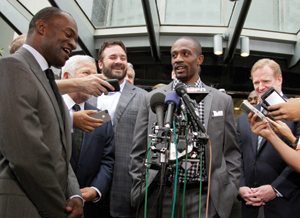NFL players could actually be better off under a new economic system in which they are paid a percentage of all revenue than they would have been had they kept the old system in place, player representatives said last week.
According to terms of the deal that NFL Players Association leaders approved last week, players will receive a lower share of revenue — 47 percent versus 50 percent — than they received previously. But the new system provides for an all-revenue model, one in which players will no longer give owners credit for expenses that were continuing to grow under the old collective-bargaining agreement.
 |
AP IMAGES
Said the Ravens’ Domonique Foxworth: “I think it’s a great deal for both sides.” |
“Our projections are our percentages would have dropped if we had stuck with the old system,” said NFLPA Executive Committee member Domonique Foxworth.
Additionally, under the settlement agreement that is to serve as the basis of the new, collective-bargaining agreement, players get a guarantee that owners will spend 99 percent of the 47 percent of revenue in cash on players, a certainty they never had before.
That is not to say that players won this negotiation. The NFL asked for and received concessions from players, including what owners wanted on the length of the deal: 10 years, with no opt out. Players also agreed to continue to allow owners to take a cost credit of 1.5 percent of revenue for new stadium construction. But in addition to new work rules that players say will improve their quality of life and hopefully lengthen their careers, there were financial aspects to the deal that made it palatable to players.
“I think it’s a great deal for both sides and I think it is the best deal we could have gotten,” said Foxworth, a cornerback for the Baltimore Ravens.
Under the old system, the owners took expense credits off the top of the revenue pie before calculating the salary cap. Under the new system, players get a straight percentage of revenue.
“If you want to look at it as 50 percent versus 47 percent you can, but it is far more nuanced than that,” said Pete Kendall, a former NFLPA leader who served as a consultant to the association during the negotiations for a new deal.
One of the things that is attractive about the new deal to players is that it removes the risk of rising costs of running NFL clubs from players. Under the old deal, NFL clubs could deduct certain costs as cost credits away from the shared revenue. Those deductions have been steadily trending upward, from $500 million in 2006, the year the now-expired CBA was signed, to $1.1 billion in 2009, the last capped year of the old CBA.
“The thing that grew the fastest wasn’t player salaries; it was club deductions,” Kendall said. Those rising deductions, Kendall added, are one reason that the percentage of revenue that went to players under the old deal dropped from 52 percent in 2006 to 50 percent in 2009.
Kendall and Foxworth agreed that although players did get things in the deal that they liked, they made concessions as well.
The players went into the negotiation saying they would not give back to the owners unless they opened their books and showed players their audited financials. That was the something the owners refused to do throughout the negotiations, but players were willing to change the split of revenue after owners showed them that players received about 53 percent of incremental revenue in the last CBA. The players were willing to flip the split in favor of the owners in order to have labor peace.
In March, before the NFLPA decertified and the league locked out players, the players and owners were talking about a pegged-cap system in which owners would get the majority of new revenue, about 55 percent. That deal fell apart when the owners took the “true up” — the mechanism that would have allowed players to share in the future growth of revenue — off the table, players said.
Kendall acknowledged that the percentage switch in the new deal of 5 percent or 6 percent to the owners was similar to what both parties were talking about in March, but the one huge difference is that under the all-revenue model that is the basis of this deal, players will be able to participate in the future growth of the league. Foxworth echoed that the deal they accepted was better than the one they rejected in March.
“No, the March deal was not attractive at all,” he said. “Had we accepted the March deal, [NFLPA Executive Director] De [Smith] would not have had a job for the rest of this year and neither would I.”




